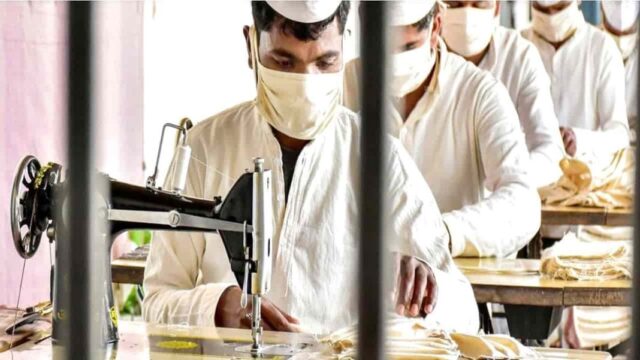As of 2022, India has roughly 1,400 prisons housing 5.73 lakh inmates, over 75% of whom are undertrials. Despite the landmark Supreme Court judgement from 1998, according to which, no inmate can be put to work without pay, all of these inmates have, at some point during their time inside, worked in one capacity or the other, regardless of whether or not they were paid for it.
Prison wages are far below the minimum in nearly every State in India. Life after release can be a challenge for most prisoners due to a lack of adequate training or reskilling opportunities.
The Core Of The Issue:
The guiding principle for prison management in India, the Model Prison Manual, 2003, stipulates that “the salaries given to workers should not be minimal or trifling, but rather fair and equitable. These rates, which must be paid to employees, must be standardised and frequently changed in compliance with government notices clarifying/ changing the appropriate minimum wages.”
It is up to the individual State governments to fix minimum wages for prisoners based on their broad classification as skilled, semi-skilled, or unskilled workers. However, as of 2022, in at least 14 States and Union Territories, the minimum prison wage for skilled work is set at less than Rs. 100 per day.
Wages for prison labour differ from one state to another. For example, a convict in Maharashtra, Goa, Haryana or Assam, on average, earns INR 70 per day for skilled work whereas their counterpart in Delhi’s Tihar jail makes between INR 194 for unskilled labour and INR 308 for skilled labour. The regular minimum wage in the capital of the country, that is, Delhi, is Rs. 495 for unskilled labourers and Rs. 600 for skilled labourers.
Sudha Bharadwaj, an activist, lawyer and author of ‘From Phansi Yard: My Year With The Women Of Yerawada’, says, “Women convicts work in Yerawada’s prison fields throughout the year, braving the heat and cold, and donning plastic sheets in the monsoon.
The wages are not great, but what mattered to them was the remission they got. For each day of work, they earned a day of remission. So, it is not the judicial system, but their hard labour that helps them go home early.”
Also Read: ResearchED: Menial Chores, Stolen Thesis, Sexual Advances: Toxic Life Of PhD Scholars
The Importance Of Wages For Prison Labour:
Wages accord dignity to prisoners’ labour. Besides fostering emotional well-being, they also incentivise good behaviour and productivity.
Prison labour allows these institutions to reduce their operating costs, and also equips those incarcerated with skills or training for gainful employment upon release.
67-year-old G. Thangavelu, a former life convict recently released, says ”Prisoners get work at the whims and fancies of jail officials. Also, we are paid poorly and not as per the Minimum Wages Act. When we went on a strike demanding our wages, all of those who agitated were shifted to different prisons in the state.”
Kiran Bedi, a retired IPS officer and who also won The Magsaysay Award in 1994 for her reform measures at Tihar Jail, said “We can build on time in hand with prisoners, and create an ecosystem wherein prisons can become rehab and skilling centres. When a prisoner enters the system, a work profile with details of his education and employment must be created and shared across all jails. His skills must be marketed so work orders can be accepted from anywhere.”
Training For Prison Inmates:
For a handful of lucky ones, there is room for creativity in jails. As part of Jaipur Rugs’ Freedom Manchaha Project, prisons across Rajasthan teach inmates how to weave and hand-knot carpets.

This is not the only state to offer training to its prisoners. The ‘Classical and Commercial Arts’ vocational training course launched by Kerala three years ago, focuses on mural and canvas paintings, wooden decorative items and ‘nettipattam’, which are caparisons donned by elephants during temple festivals.
However, ex-convicts and former inmates allege that the labour is far from useful for employment after their jail term and the working conditions within continue to be punishing in nature.
In fact, one of the most powerful countries, the United States of America, which imprisons more of its population than any other country in the world, is no better. Surprisingly, only around two-thirds of all prisoners in the country have jobs in state and federal prisons.
According to a report from the American Civil Liberties Union (ACLU), incarcerated workers in the US produce at least $11 billion in goods and services each year but receive just pennies an hour in wages for their prison jobs. The findings in the report raise concerns about the systemic exploitation of prisoners, who sometimes are forced to do difficult and dangerous jobs without basic labour protections and little or even no training while making almost nothing.
Thus, extensive changes around the use of prison labour are required, while also ensuring that such work is voluntary and provides workers with equitable wages and protections as well as work programs that give prisoners marketable skills and training.
Image Credits: Google Images
Feature image designed by Saudamini Seth
Sources: The Hindu, The Guardian, Live Law
Find the blogger: Unusha Ahmad
This post is tagged under: prisoners, prison, inmates, India, Delhi, Maharashtra, Goa, Rajasthan, Supreme Court, labour, wages, Model Prison Manual 2003, UT, governments, USA, US, Haryana, Assam, Tihar jail, labourers, Yerawada, Kiran Bedi, IPS, Magsaysay Award, rehab, skilling centres, Rugs’ Freedom Manchaha Project, Jaipur, Classical and Commercial Arts, Kerala, nettipattam, ACLU
Disclaimer: We do not hold any right, copyright over any of the images used, these have been taken from Google. In case of credits or removal, the owner may kindly mail us.
Other Recommendations:
ResearchED: Why Does India Have Third-Highest Percentage Of ‘Zero-Food Children’